List of chief ministers of Karnataka
The Chief Minister of Karnataka is the chief executive of the Indian state of Karnataka. As per the Constitution of India, the governor is a state's de jure head, but de facto executive authority rests with the chief minister. Following elections to the Karnataka Legislative Assembly, the state's governor usually invites the party (or coalition) with a majority of seats to form the government. The governor appoints the chief minister, whose council of ministers are collectively responsible to the assembly. Given that he has the confidence of the assembly, the chief minister's term is for five years and is subject to no term limits.[1]
| Chief Minister of Karnataka | |
|---|---|
 | |
| Status | Head of Government |
| Abbreviation | CM |
| Member of | Karnataka Legislative Assembly |
| Reports to | Governor of Karnataka |
| Residence | Anugraha, Kumarakrupa Road, Bangalore |
| Appointer | Governor of Karnataka |
| Term length | At the confidence of the assembly Chief minister's term is for five years and is subject to no term limits.[1] |
| Inaugural holder | K. Chengalaraya Reddy |
| Formation | 25 October 1947 |
| Deputy | Govind M. Karjol |
| Website | https://karnataka.gov.in, https://cmkarnataka.gov.in |
Since 1947, twenty-two people have been Chief Minister of Mysore (as the state was known before 1 November 1973) or Karnataka. A majority of them belonged to the Indian National Congress party, including inaugural office-holder K. Chengalaraya Reddy. The longest-serving chief minister, D. Devaraj Urs, held the office for over seven years in the 1970s. The Janata Party's Ramakrishna Hegde has the second-longest tenure, while the Congress's Veerendra Patil had the largest gap between two terms (over eighteen years). One chief minister, H. D. Deve Gowda, went on to become the eleventh Prime Minister of India, while another, B. D. Jatti, served as the country's fifth Vice President. There have been six instances of president's rule in Karnataka, most recently in 2007–08.
The incumbent chief minister is the Bharatiya Janata Party's B. S. Yediyurappa, who was sworn in on 26 July 2019.
Chief ministers of Mysore and Karnataka
| Colour key for parties |
|---|
| No.[lower-alpha 1] | Name | Portarit | Constituency / Representation From |
Term[2] (tenure length) |
Assembly[3] (election) |
Party[lower-alpha 2] | |||
|---|---|---|---|---|---|---|---|---|---|
| Chief Minister of Mysore[lower-alpha 3] | |||||||||
| 1 | K. Chengalaraya Reddy | 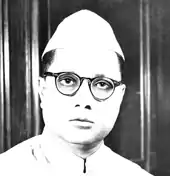 |
Mysuru State | 25 October 1947 |
30 March 1952 | 4 years, 157 days | Not established yet | Indian National Congress | |
| 2 | K. Hanumanthaiah | Mysuru State | 30 March 1952 |
19 August 1956 | 4 years, 142 days | First Assembly (1952–1957) (1951–52 election) continued... | |||
| 3 | Kadidal Manjappa |  |
Mysuru | 19 August 1956 |
31 October 1956 | 73 days | |||
| Chief Minister of Mysore (following the state's reorganisation)[lower-alpha 4] | |||||||||
| 4 | S. Nijalingappa |
.jpg.webp) |
Molakalmuru | 1 November 1956 |
16 May 1958 | 1 year, 197 days | ...continued First Assembly (1952–1957) (1951–52 election) |
Indian National Congress | |
| Second Assembly (1957–1962) (1957 election) | |||||||||
| 5 | B. D. Jatti |
.png.webp) |
Jamkhandi | 16 May 1958 |
9 March 1962 | 3 years, 297 days | |||
| 6 | S. R. Kanthi |
Hungud | 14 March 1962 |
20 June 1962 | 98 days | Third Assembly (1962–1967) (1962 election) | |||
| (4) | S. Nijalingappa |
.jpg.webp) |
Shiggaon | 21 June 1962 |
28 May 1968 | 5 years, 342 days | |||
| Fourth Assembly (1967–1971) (1967 election) | |||||||||
| 7 | Veerendra Patil | Chincholi | 29 May 1968 |
18 March 1971 | 2 years, 293 days | Indian National Congress (O) | |||
| – | Vacant[lower-alpha 5] (President's rule) |
 |
N/A | 19 March 1971 |
20 March 1972 | 1 year, 1 day | Dissolved | N/A | |
| Chief Minister of Karnataka[lower-alpha 6] | |||||||||
| 8 | D. Devaraj Urs |
 |
Hunsur | 20 March 1972 |
31 December 1977 | 5 years, 286 days | Fifth Assembly (1972–1977) (1972 election) |
Indian National Congress | |
| – | Vacant[lower-alpha 5] (President's rule) |
 |
N/A | 31 December 1977 |
28 February 1978 | 59 days | Dissolved | N/A | |
| (8) | D. Devaraj Urs |
 |
Hunsur | 28 February 1978 |
7 January 1980 | 1 year, 313 days | Sixth Assembly (1978–1983) (1978 election) |
Indian National Congress (I)[lower-alpha 7] | |
| 9 | R. Gundu Rao |  |
Somwarpet | 12 January 1980 |
6 January 1983 | 2 years, 359 days | |||
| 10 | Ramakrishna Hegde |
Kanakpura | 10 January 1983 |
29 December 1984[lower-alpha 8] | 1 year, 354 days | Seventh Assembly (1983–1985) (1983 election) |
Janata Party | ||
| Basavanagudi | 8 March 1985 |
13 February 1986[lower-alpha 9] | 3 years, 155 days | Eighth Assembly (1985–1989) (1985 election) | |||||
| 16 February 1986 |
10 August 1988 | ||||||||
| 11 | S. R. Bommai |
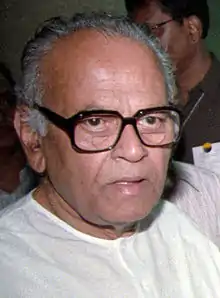 |
Hubli Rural | 13 August 1988 |
21 April 1989 | 281 days | |||
| – | Vacant[lower-alpha 5] (President's rule) |
 |
N/A | 21 April 1989 |
30 November 1989 | 193 days | Dissolved | N/A | |
| (7) | Veerendra Patil |
Chincholi | 30 November 1989 |
10 October 1990 | 314 days | Ninth Assembly (1989–1994) (1989 election) |
Indian National Congress | ||
| – | Vacant[lower-alpha 5] (President's rule) |
 |
N/A | 10 October 1990 |
17 October 1990 | 7 days | N/A | ||
| 12 | S. Bangarappa |
Soraba | 17 October 1990 |
19 November 1992 | 2 years, 33 days | Indian National Congress | |||
| 13 | M. Veerappa Moily |
 |
Karkala | 19 November 1992 |
11 December 1994 | 2 years, 22 days | |||
| 14 | H. D. Deve Gowda |
 |
Ramanagara | 11 December 1994 |
31 May 1996 | 1 year, 172 days | Tenth Assembly (1994–1999) (1994 election) |
Janata Dal | |
| 15 | J. H. Patel |
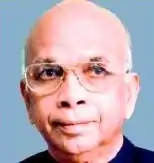 |
Channagiri | 31 May 1996 |
7 October 1999 | 3 years, 129 days | |||
| 16 | S. M. Krishna |
.jpg.webp) |
Maddur | 11 October 1999 | 28 May 2004 |
4 years, 230 days | Eleventh Assembly (1999–2004) (1999 election) |
Indian National Congress | |
| 17 | Dharam Singh |
 |
Jevargi | 28 May 2004 |
2 February 2006 | 1 year, 250 days | Twelfth Assembly (2004–2007) (2004 election) | ||
| 18 | H. D. Kumaraswamy |
 |
Ramanagara | 3 February 2006 |
8 October 2007 | 1 year, 253 days | Janata Dal (Secular) | ||
| – | Vacant[lower-alpha 5] (President's rule) |
 |
N/A | 8 October 2007 |
12 November 2007 | 35 days | N/A | ||
| 19 | B. S. Yediyurappa |
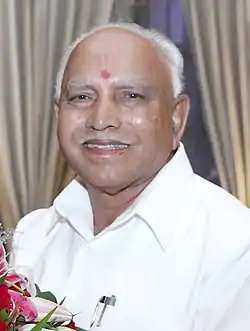 |
Shikaripura | 12 November 2007 |
19 November 2007 | 7 days | Bharatiya Janata Party | ||
| – | Vacant[lower-alpha 5] (President's rule) |
 |
N/A | 20 November 2007 |
29 May 2008 | 191 days | Dissolved | N/A | |
| (19) | B. S. Yediyurappa |
 |
Shikaripura | 30 May 2008 |
4 August 2011 | 3 years, 66 days | Thirteenth Assembly (2008–2013) (2008 election) |
Bharatiya Janata Party | |
| 20 | D. V. Sadananda Gowda |  |
MLC | 5 August 2011 |
11 July 2012 | 341 days | |||
| 21 | Jagadish Shettar |
 |
Hubli-Dharwad-Central | 12 July 2012 |
12 May 2013 | 304 days | |||
| 22 | Siddaramaiah |
.jpg.webp) |
Varuna | 13 May 2013 |
15 May 2018 | 5 years, 2 days | Fourteenth Assembly (2013–2018) (2013 election) |
Indian National Congress | |
| (19) | B. S. Yediyurappa |
 |
Shikaripura | 17 May 2018 |
23 May 2018 | 6 days | Fifteenth Assembly (2018–2023) (2018 election) |
Bharatiya Janata Party | |
| (18) | H. D. Kumaraswamy |
 |
Channapatna | 23 May 2018 |
23 July 2019 | 1 year, 61 days
(total 2 years, 314 days) |
Janata Dal (Secular) | ||
| (19) | B. S. Yediyurappa |
 |
Shikaripura | 26 July 2019 |
Incumbent | 1 year, 198 days | Bharatiya Janata Party | ||
Notes
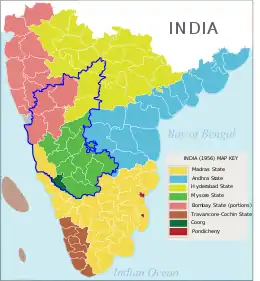
- Footnotes
| Wikimedia Commons has media related to Chief ministers of Karnataka. |
- A parenthetical number indicates that the incumbent has previously held office.
- This column only names the chief minister's party. The state government he headed may have been a complex coalition of several parties and independents; these are not listed here.
- Mysore State came into being in August 1947 when Maharaja Jayachamarajendra Wodeyar signed the Instrument of Accession to merge the Princely State of Mysore with the Dominion of India.[4]
- On 1 November 1956, via the States Reorganisation Act, Mysore State was significantly expanded along linguistic lines. The Kannada-speaking districts of Bombay, Hyderabad and Madras states, as well as the entirety of Coorg, were added to it.[5]
- President's rule may be imposed when the "government in a state is not able to function as per the Constitution", which often happens because no party or coalition has a majority in the assembly. When President's rule is in force in a state, its council of ministers stands dissolved. The office of chief minister thus lies vacant, and the administration is taken over by the governor, who functions on behalf of the central government. At times, the legislative assembly also stands dissolved.[6]
- On 1 November 1973, via the Mysore State (Alteration of Name) Act, Mysore State was renamed as Karnataka.[5] Thus, Devaraj Urs was Chief Minister of Mysore between 20 March 1972 and 31 October 1973, and Chief Minister of Karnataka after that.
- In mid-1979 Urs split from the Indira Gandhi-led Congress (I), and served the remainder of his term as an Indian National Congress (Urs) member.[7]
- According to Frontline magazine, "Following the poor performance of the Janata Party in the 1984 [general] elections (it won only four out of the 28 seats), Hegde resigned on the grounds that his party had lost its popular mandate. Prime Minister Rajiv Gandhi allowed him to head a caretaker government. In the 1985 [assembly] elections the Janata Party came to power with a comfortable majority."[8]
- According to Frontline, Hegde resigned "in February 1986 when the Karnataka High Court censured his government for the way it handled arrack bottling contracts".[8] He withdrew his resignation after a couple of days, "following pressure from his party legislators".[9]
- References
- Durga Das Basu. Introduction to the Constitution of India. 1960. 20th Edition, 2011 Reprint. pp. 241, 245. LexisNexis Butterworths Wadhwa Nagpur. ISBN 978-81-8038-559-9. Note: although the text talks about Indian state governments in general, it applies for the specific case of Karnataka as well.
- Chief Ministers of Karnataka since 1947. Karnataka Legislative Assembly. Archived on 6 December 2016.
- Assemblies from 1952. Karnataka Legislative Assembly. Archived on 6 December 2016.
- "Corrections and Clarifications". The Hindu. 4 October 2006. Archived on 6 March 2014.
- M. S. Prabhakara. "New names for old". The Hindu. 24 July 2007.
- Amberish K. Diwanji. "A dummy's guide to President's rule". Rediff.com. 15 March 2005. Retrieved on 3 March 2013.
- Arul B. Louis et al. "Janata Party and Congress(I) disintegrate into frenzied bout of factionalism and power struggles". India Today. 15 July 1979.
- Parvathi Menon. "A politician with elan: Ramakrishna Hegde, 1926–2004". Frontline. Volume 21: Issue 03, 31 January – 13 February 2004.
- A. Jayaram. "Pillar of anti-Congress movement". The Hindu. 13 January 2004.